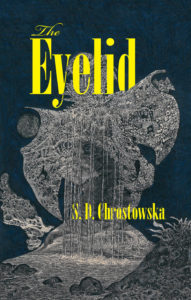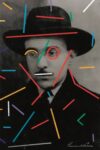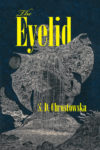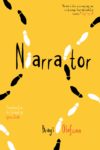
[Coach House Books; 2020]
S. D. Chrostowska’s The Eyelid is an exquisite piece of literature which might well become an instant cult book until it makes its way to a much deserved place at the top of any list of utopian-dystopian fiction masterworks. Timely and timeless, written in the style of the most extraordinary fabulists, and recalling some encouraging ideas from the past centuries’ revolutionaries and utopianists, The Eyelid is a poetic exploration of sleep and a guided excursion to a marvelously idiosyncratic land of dreams. Wisely insurrectional, like any authentic aesthetical endeavor, it confronts us with a fictional environment — one not so different from our own society — in which both sleeping and dreaming are being culturally and politically threatened:
in which dreams were like all other things — for sale, existing only to be fulfilled, and otherwise without the right to exist.
The Eyelid is a tale about how freedom was exchanged for a squalid fantasy of control. Only those who imagine themselves free can live in a world of never-fulfilled dreams, as Fernando Pessoa wrote in The Book of Disquiet:
No one can be king of the world except in dreams. And every one of us who really knows himself wants to be king of the world. To imagine, without being, is the throne. To desire, without wanting, is the crown. We have what we renounce, for we conserve it eternally intact in our dreams, by the light of the sun that isn’t, or of the moon that cannot be.
Relentlessly invited to be vigilant about nonstop and ever changing visual stimuli, with our eyes permanently plugged to an ubiquitous orb which requires everything in the world to be unceasingly screened by every human being on Earth, eyelids work as paper-thin doors of perception that, almost imperceptibly, through gentle and effortless closure, open the possibility of a language. The Eyelid is a refreshed dream of dreams inspired by the great dreamers of all times — Schwob, Pessoa, Swift, Schulz, Manganelli, Carroll, and Poe — and invoked from a para-modern nonconformist past. The story Chrostowska dares to dream in her intensely poetic, straightforward narrative style, is presented as a series of powerfully evocative short scenes taken from a journey through the looking-glass of lucid unconsciousness, following the narrator’s first encounter with Chevauchet, ambassador of Onirica and her cicerone across the republic of dreams — “dreams that could be neither bought nor possessed, strictly immaterial, and given away in this form to kindred spirits.”
Gaston Bachelard’s The Poetics of Reverie was probably the most famous among contemporary attempts to theorize “oneiroaesthetics” — the aesthetics of dreaming. Dreams, daydreaming, and sleep itself were once regarded as sources of all arts, but those times seem to be gone or at least vanishing. Notwithstanding the surrealists and “psychedelians” (or perhaps with their complicity), dreams became the subject and the prey of psychoanalysis, which continued the tradition of associating the labor of sleep with a series of narratives and culturally saturated symbols that might be interpretated and exploited. Since the earliest recordings of EEG waves, neurophysiologists claimed sleep as a part of their research field. Both dreaming and sleeping were quickly classified as reservoirs of “useful” information — for instance, the intense brain activity during sleep and the role of REM sleep on memory consolidation are not communicated as ‘neutral’ neurophysiological mechanisms, but more often as a “justification” for otherwise “inexplicably long” periods of apparent unproductivity and inaction. Chrostowska chooses wisely her inspiration: Lucian of Samosata, La Boétie and Charles Lassailly, instead of Artemidorus and Freud. Early in the book, Chevauchet states that “what you dream of is less important than that you dream and keep dreaming.” He explains to the narrator,
As soon as you turn something into a means, its value in itself is put into question. Dreaming for its own sake — without some ulterior motive, some enhancement of life — holds no more worth. You are approaching a state of absolute sleeplessness, without even realizing it, because what you value above everything else is being conscious. The rest — sleeping, dreaming, idleness — seems primitive by comparison, the preserve of unreason, of myth. The way things are going, you will get rid of it all soon enough.
Eyelids are the instruments for disconnection, the switches to swift worlds for staying away from any purpose. Since every form of authoritarianism runs on the promise of fulfillment, technocratic tyrants-to-be daydream of a coming society in which sleep will become pure annoyance; it will finally be rendered useless, the useless worthless, and the worthless eventually terminated, tightly regulated, or, at least, off-marketed. It’s by no means a coincidence that Chrostowska‘s characters find most of the action in underground Paris, former capital of insurrection and utopia:
Utopia was quite simply the plurality of dissonant dreams and poetic traditions, chief among them being Romanticism and Surrealism. These utopian currents awoke latent myths containing values of the unjustly silenced, the vanquished — values that any oppressed could claim and incarnate, bringing to life in this way past struggles and lost causes, redeeming them. This kept the sphere of action open for universalization. But values could also be co-opted, turned against themselves, dialectically reappropriated. They were in constant danger of ending up as grist or caught in the “birdlime’ of ideology.
Oneiroaesthetics might be traced to the origins of written literature and most oral traditions, yet there’s hardly notice of literary approaches to “hypnoaesthetics.” This lack contrasts with the visual arts, in which representations of the sleeping human body have been frequent since classical times. The most interesting aesthetical explorations of contemporary sleep were perhaps those focused on its disruption and related disorders. A comparative historical study of the last 100 years in world literature could well be about tracing insomnia and the pharmaceutical evolution of sleeping pills. In The Eyelid, however, sleep, dreaming, and waking appear re-naturalized and are treated as equals: “In Onirica, you see, we are asleep and awake at the same time. But we need sleep just as we need waking life. They are inseparable. It is wrong to exploit sleep: to sleep in the service of life, in order to live. It upsets a natural balance.” In the waking world, natural sleep becomes a revolutionary act.
As the story goes on, productive forces retaliate against “wishful thinking and the creative imagination.” Sleep is denounced as the sorce of all idleness, and soon outlawed. A drug is designed to achieve high-functioning sleeplessness. Voluntary sleepers are prosecuted and punished with unmedicated sleep deprivation. The weak resistance, organized with the help of Chevauchet in an isolated country house, “large enough to sleep several dozen souls” is finally detected and crushed by the police.
The Eyelid comes out during an unexpected period of forced unproductivity due to the COVID crisis, which also feels like the prequel of a quietist insurrection. The modern process of embodiment has developed from an idealistic concept of our physical realities. In consequence, sleep and dreams are supposed to be “installed” in a model-body which comes permanently unfinished and in need for constant improvement, maintenance, workout, and prosthetic technologies. Every bodily function is expected to be hacked and replaced by an upgraded synthetic version of itself, and most technical applications have been developed with that purpose in mind. The Eyelid invites us to consider a different body and different technologies — not modern, but decadent ones. Not coded but ritualized. Not aimed for improvement, but for pleasure: “Upon lidless eyes flies soon come to rest. But the corpse in whose orbits they will lay their eggs has seen happiness.” “Decadence”, as Joyelle McSweeney wrote, “is the deeper vision.” Sweet dreams are made of this.
Germán Sierra is a writer and neuroscientist living in Spain. He has authored six books of fiction in Spanish, and one in English entitled The Artifact, published in 2018 by Inside the Castle.
This post may contain affiliate links.







